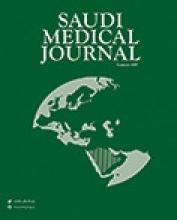Abstract
OBJECTIVE: To compare the resistance pattern of common bacterial pathogens to commonly used drugs.
METHODS: Information and statistics of antimicrobial resistance for 1994 and 2005 were collected from the 3 hospital microbiology laboratories in the United Arab Emirates. The resistance patterns of Staphylococcus aureus, Escherichia coli, Klebsiella spp, and Pseudomonas aeruginosa to several front-line drugs were estimated. All laboratories used automatic machines (Vitek 2), which identifies and determines minimum inhibitory concentrations simultaneously.
RESULTS: Increased resistance was observed for Staphylococcus aureus, (n=315, 2005) to erythromycin (approximately 6 fold, Al-Ain Hospital only), cloxacillin (Al-Ain Hospital), and gentamicin (more than 3-10 folds in all hospitals). Increased penicillin resistance was not observed. For the common Gram-negative organisms, there was a high resistance to ampicillin, gentamicin, ceftriaxone, ciprofloxacin, and imipenem, which seemed to increase for Escherichia coli, (by 4.2-200%, n=305, 2005); however, there was very little resistance to imipenem (0.4%) in Tawam Hospital. Variable resistance patterns were obtained for Pseudomonas aeruginosa (n=316, 2005) and Klebsiella spp,(n=316, 2005) against aminoglycosides, cephalosporins, ciprofloxacin, and norfloxacin.
CONCLUSION: Overall, there was an obvious increase in resistance of bacteria and the prevalence rate to a number of drugs from 1-120 folds during the 11-year period.
- Copyright: © Saudi Medical Journal
This is an open-access article distributed under the terms of the Creative Commons Attribution-Noncommercial-Share Alike 3.0 Unported, which permits unrestricted use, distribution, and reproduction in any medium, provided the original work is properly cited.






